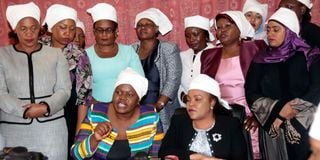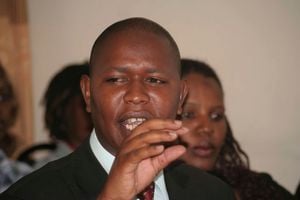Are we getting the most out of our Woman Reps?

The Kenya Women Parliamentary Association (Kewopa) address the media in this file photo taken in 2018. The organisation, last week, held an X space titled “The Role of the Woman Representative in Leadership and Governance.”
What you need to know:
- The County Woman Rep position, established through affirmative action, has provided a platform for women in politics.
- However, its effectiveness and the true impact on women’s representation remain debated.
- While the position has achieved some successes, questions persist about its long-term viability and the need for further reforms to ensure meaningful women’s representation in Kenyan leadership.
Article 97 (1) (b) of the Constitution of Kenya created the affirmative position of 47 women elected at county level. The debate on this position led the Kenya Women’s Parliamentary Association (Kewopa) to host a public forum titled “The Role of the Woman Representative in Leadership and Governance” in the X-space on September 18. The thrust was on whether the public really understands the role and value of this position. Various perspectives emerged.
The role of county women representatives (CWRs) should be looked at in the context of the paucity of women Parliament. The first consideration is that the position guarantees a certain minimum number of women in the legislature which, added to those elected in open seats, increases their number and grants them higher visibility, potentially more debating opportunities and ability to counter male domination in voting.
Needless to say, the presence of women in leadership positions debunks the notion that only men can lead. It also provides the electorate with a wider pool to choose from, which enhances democracy and improves the quality of governance.
It emerged that the CWRs consider themselves not only as beneficiaries of affirmative action but also its automatic champions. This is what Priscilla Nyokabi, former Nyeri CWR, referred to as the 3-plus one mandate - that on top of legislation, representation and oversight, CWRs also focus on marginalised groups and issues. This niche is not prescribed for them but is one they have defined for themselves. In legislative work, people can choose, pursue and specialise on their pet subjects. Thus, CWRs cannot be faulted for choosing to focus on specific issues.
Read: Explainer: Women reps are not elected to represent women but as women
Globally, legislation is mainly done through departmental committees. A high number of women in the legislature means that more get their way into committees as members and chairpersons. This puts them at a vantage point to monitor the progress of legislation, influence the wording of proposed laws and mobilise the support of male colleagues on specific agenda.
The CWRs often cite the establishment of the National Government Affirmative Action Fund as a major achievement. This is a kitty they petitioned for based on the argument that while the single constituency members of parliament (MPs) had the Constituency Development Fund to finance their “development” activities, the CWRs had nothing, hence, were relatively invisible and irrelevant in the eyes of the electorate. This itself, is based on a rather distorted practice of the electorate expecting MPs to put up structures and provide services, which is the work of the executive. This is an unfortunate creation of the political class that should be eradicated.
The discussion also looked at the permanency of the CWR position. By definition, affirmative action is a temporary measure that is phased out once historical imbalances have been addressed and parity is achieved. The constitution neither specifies when the affirmative position should lapse nor does it prescribe the maximum terms an individual can hold the post consecutively or otherwise.
But there is a tacit understanding that holders of the position should treat it as a stepping stone to other posts. The theory is that when occupiers move to other positions, they create room for more women in leadership. A good example is that of Rosa Buyu, the county woman rep for Kisumu County in the last parliament. Her movement to the Kisumu West single constituency seat means there are now two women from the county in the National Assembly.
The issue of double standards also came up, that women tend to be judged more harshly than men in similar circumstances. It was pointed out that while critics are quick to criticise CWRs, they are loudly quiet about the majority men who hardly say anything in parliament. This is the problem of being in the limelight – that those in a minority stand out and are subjected to higher scrutiny that those in the majority.
A persistent question is on who the CWRs represent. This confusion arises from the naming of the position. The term County Woman Representative is actually not in the constitution but was coined by the Independent Electoral and Boundaries Commission during the 2012 elections and has since stuck. The forum clarified that CWRs represent and are elected by both women and men in the respective counties. One speaker proposed that the name be changed to County MP.
As the debate continues, it should be noted that when Kenyans endorsed the constitution in 2010, they approved this position. Impliedly, they saw something useful in it. Does this still stand? It is also over a decade since the constitution came into effect. Is it perhaps time to reflect on what gains have been, including through this position?
The writer is a lecturer in Gender and Development Studies at South Eastern Kenya University ([email protected]).





